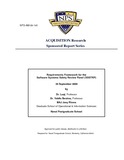Electronic attack platform placement optimization
| dc.contributor.advisor | Pace, Phillip E. | |
| dc.contributor.advisor | Ford, Patrick | |
| dc.contributor.author | Braud, Jeremy J. | |
| dc.date | Sep-14 | |
| dc.date.accessioned | 2014-12-05T20:09:56Z | |
| dc.date.available | 2014-12-05T20:09:56Z | |
| dc.date.issued | 2014-09 | |
| dc.identifier.uri | https://hdl.handle.net/10945/43881 | |
| dc.description.abstract | An increasingly dynamic battlefield requires increasingly faster software development. Cyber threats and Information Assurance certifications induce significant delays in software operational deployment designed to meet these emerging battlefield requirements. An alternative software development methodology for Department of Defense (DOD) acquisitions was proposed. The proposed software development methodology uses tailoring of commercial pre-approved applications such as Microsoft Office and Adobe currently available on most DOD networks. The application developed to test the validity of this approach is called the electronic attack platform placement optimization (EAPPO) algorithm. Given digital terrain data, a user inputted strike route, and an enemy order-of-battle (EOB) with their respective jammer techniques as inputs, the application output includes terrain and radar impacted threat range rings, aircraft strike routes, and an optimized flight path for the jamming platform (EA-18G). Successful development of the application validates the potential of using pre-approved, non-compiled software to develop military specific applications, a process that could significantly decrease software development time and cost for the DOD. | en_US |
| dc.description.uri | http://archive.org/details/electronicttackp1094543881 | |
| dc.publisher | Monterey, California: Naval Postgraduate School | en_US |
| dc.rights | This publication is a work of the U.S. Government as defined in Title 17, United States Code, Section 101. Copyright protection is not available for this work in the United States. | en_US |
| dc.title | Electronic attack platform placement optimization | en_US |
| dc.type | Thesis | en_US |
| dc.contributor.secondreader | Fouts, Douglas | |
| dc.contributor.department | Electrical and Computer Engineering | |
| dc.subject.author | Jamming | en_US |
| dc.subject.author | EA-18G | en_US |
| dc.subject.author | Linear Programming | en_US |
| dc.subject.author | Dynamic Programming | en_US |
| dc.subject.author | Microsoft Office | en_US |
| dc.subject.author | GPU | en_US |
| dc.subject.author | Radar | en_US |
| dc.subject.author | Bresenham Algorithms | en_US |
| dc.subject.author | DTED | en_US |
| dc.subject.author | Excel Graphics | en_US |
| dc.subject.author | Enemy Order of Battle | en_US |
| dc.subject.author | Integrated Air Defense Systems | en_US |
| dc.subject.author | Protected Entity | en_US |
| dc.subject.author | Airborne Electronic Attack | en_US |
| dc.description.service | Lieutenant Commander, United States Navy | en_US |
| etd.thesisdegree.name | Master of Science in Electrical Engineering | en_US |
| etd.thesisdegree.level | Masters | en_US |
| etd.thesisdegree.discipline | Electrical Engineering | en_US |
| etd.thesisdegree.grantor | Naval Postgraduate School | en_US |
| dc.description.distributionstatement | Approved for public release; distribution is unlimited. |
Files in this item
This item appears in the following Collection(s)
-
1. Thesis and Dissertation Collection, all items
Publicly releasable NPS Theses, Dissertations, MBA Professional Reports, Joint Applied Projects, Systems Engineering Project Reports and other NPS degree-earning written works.





